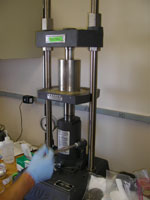Kevin Mandernack (Colorado School of Mines – Golden – Colorado USA)
Stefan Voggel (Northern Illinois University – DeKalb – Illinois USA)
Our journey to meet ANDRILL’s research teams begins with the first group, which starts to work very hard and from the earliest stages, on the cores: this is the Microbiology and Interstitial water group. This team springs into action on the very first cores that are extracted from the ocean floor; the first analyses, in fact, were carried out on the 19th of October 2006.
What’s analysed?
Both the sediment (clasts) and the interstitial water, that is the water which resides among the clasts, are analysed.
Which analyses are carried out?
Both Chemical and Microbiological tests are done.
The water’s pH, alkalinity and conductivity are measured, along with the concentration of nitrogen forms (ammonia nitrogen), organic and inorganic carbon and other dissolved elements.
The sediment’s total carbonate content is estimated as well as the concentration of oxygen isotopes, to determine the ratio of O-16 to O-18.
On the sediment, Microbiological analyses are also carried out: estimation of the total bacterial content, DNA analysis, cell membrane phospholipids analysis and carbon isotopes analysis to estimate the ratio of C-12 to C-13.
Microbiological analyses are carried out on sediment taken from the first few meters only, because below a certain depth, microbiological activity ceases. Just think that the last remaining traces of DNA are found at a depth of just 30 meters.
Chemical analyses, on the other hand, are carried out whenever water is present, and on the contrary to what you may think, some water is always found trapped within the rocks (sedimentary), even 1000 meters underneath the ocean floor. Extracting the water is not an easy job, but it is possible: pressures of up to 3,000 kg per square centimetre are applied for a day or longer, in order to obtain even a few millilitres of water- enough to perform the tests.
Some analyses are carried out immediately (pH and alkalinity) while the remaining ones are performed later on in the laboratories of the project’s participants.
How are the analyses done? (See photogallery 5)
 The cores arrive at the laboratory and are cut into 5 cm-long sections. A few grams are sampled from the surface layers first of all and destined for microbiological analyses, then from these ‘mud cylinders’, water is extracted. A press which reaches pressures of hundreds of kg per square centimetre is used, and the sample is left under these conditions for about two hours. Following this treatment, 30 ml of intestital water and a very compact sediment disk are obtained. The water’s pH and alkalinity are analysed straight away.
The cores arrive at the laboratory and are cut into 5 cm-long sections. A few grams are sampled from the surface layers first of all and destined for microbiological analyses, then from these ‘mud cylinders’, water is extracted. A press which reaches pressures of hundreds of kg per square centimetre is used, and the sample is left under these conditions for about two hours. Following this treatment, 30 ml of intestital water and a very compact sediment disk are obtained. The water’s pH and alkalinity are analysed straight away.
A volume of water and the sediment disk is stored away in a refrigerator for further analysis later on.
What is found out?
Chemical and isotope analyses of the water and sediment give us a clue about the type of (paleo) environment in which sedimentation took place The oxygen isotope analysis in particular is very useful.
Microbiological analyses have a slightly different objective. The organisms which are able to thrive without light, at a depth of a 1000 meters in temperatures around zero degrees are very little known and studied. These special organisms belong to the ‘extremophiles’ category. The ANDRILL project offers an exciting and unique opportunity for microbiologists to study these organisms.